Q&A – Ask Neil: May 30, 2024 – Part 2
QUESTION 8
HOW FAR APART SHOULD CARISSA HOLLIES BE SPACED?
Question: I am planting Carissa hollies to replace Indian hawthorns that were killed in the freeze of February 2021. They will be beneath a magnolia tree, so they will get periods of sun and shade during the day. Is there another choice for my area? Christina H., Fort Worth.
Answer: Carissa hollies should be fine as long as you keep them moist at all times and as long as you don’t plant them where they will get reflective heat from a concrete wall or foundation. You asked about other alternatives in the 3-4 ft. range. I just planted 30 dwarf Chinese hollies. They grow to just about the same size and form, which stands to reason since they’re the plant from which Carissas were selected as mutations. I’ve found them to be extremely durable, although more prickly. I have them along a couple of paths and bed borders and I’ve never had any issues with people running into them. They’re not as common in nurseries as they used to be, but they’re definitely available.
QUESTION 9
I’VE DIAGNOSED THIS AS ROSE ROSETTE VIRUS. WAS I CORRECT?
Question: The close-up photo is from a Knockout rose planted four weeks ago. Based on the thick cane and large thorns I diagnosed rose rosette virus. I’ve also attached a photo of one of three other plants planted at the same time. Should they all be dug up? Mark M., Bexar County.
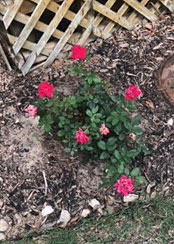
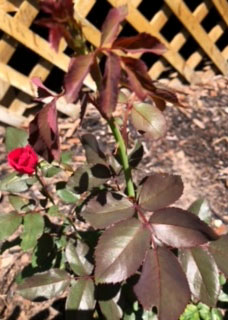
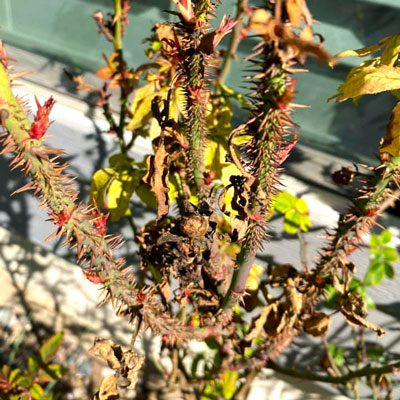
Answer: I do not, to the best of my ability, see any evidence of rose rosette virus in your photos. Their resolution is too low to allow zooming to enlarge. You shouldn’t be looking solely for large canes and large thorns, but a huge number of thorns as one prime indicator. I’ve attached a photo of a plant that was overwhelmed by RRV and you can see how those canes have 10 or 20 times the normal number of thorns. At this point you do not need to dig and remove your roses. I hope that continues for you. Here is a lot more information I leave archived on RRV on my website.
QUESTION 10
WHAT IS WRONG WITH MY TEXAS SAGE?
Question: Here is my Texas sage that was lush before all these rains. Last year the rains did not have this effect. The plant is growing in heavy black clay and the leaves are now looking bad. What can I do? Paula L., Carrollton.
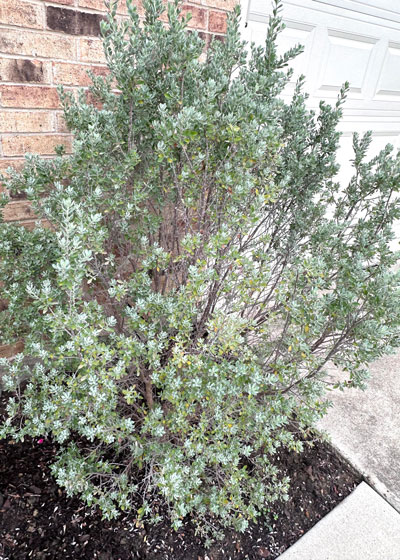
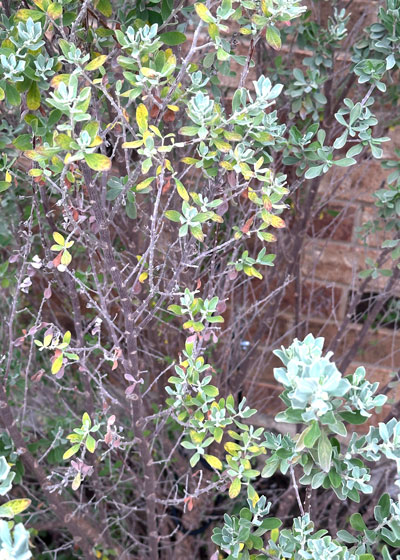
Answer: This year’s rains have far exceeded last year’s in the Metroplex where you live. Texas sage plants have also been brutalized the past several winters by the very low temperatures, starting in February 2021 and continuing on to two other cold spells since then. You can see it in the plantings along area toll roads and state highways where TxDOT has authorized their planting. North Central Texas winters and frequent wet springs are two reasons that this plant is not native to your part of Texas. In your specific situation, I also wonder if your plant could also be getting additional runoff trapped in its soil up in that corner of your house. The soil in that spot may be wetter than elsewhere in your landscape. By any chance, do you have a downspout that empties anywhere nearby? If you can nurse the plant through the summer and fall, it might do better in a raised bed somewhere that the soil could drain quickly following rains.
QUESTION 11
SHOULD I CUT THIS CRAPE MYRTLE TO THE GROUND, OR JUST REMOVE THE DEAD PARTS?
Question: This crape myrtle is at least 30 years old. Should I cut out the dead parts or cut it completely to the ground and let it start over? V.A., Gilmer.
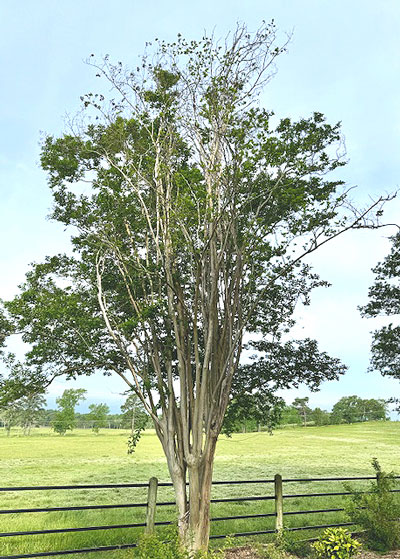
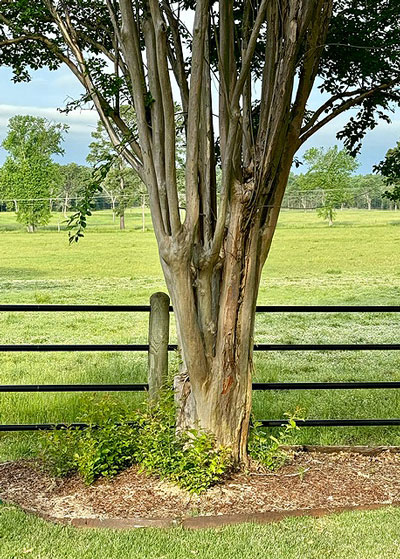
Answer: What a wonderful question! I wish I had a definitive answer for it! My first response was that you should remove the dead stems, and that still would probably be a good beginning. However, there’s going to be an awkward cutting job involved that will require a pruning saw operated by hand. It may be difficult (but essential) to remove that trunk from the middle of the plant without leaving a stub that could lead to decay. It could also leave you with a lopsided plant.
If you were to cut this plant back to the ground as you’ve apparently seen me recommend, it would come back symmetrically (without a flat side). You can see that it’s already sending up numerous shoots that would become its new trunks. You could select from them to choose the straightest 5 to 7, eventually narrowing it down to 3 trunks. By cutting it back you would also be able to get rid of the crooks in the trunks where it was topped several years back. You will be amazed at how quickly it grows back, especially if you apply a high-nitrogen plant food and keep it moist all through the summer.
QUESTION 12
WHAT IS THE FLOWER IN DIANE SITTON’S SECOND PHOTO, LAST WEEK’S STORY?
Question: What is the name of the pink flowers in Diane Sitton’s story last week (second photo)? Betty W., Dallas.
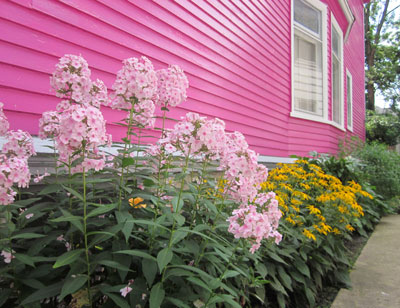
Answer: Diane did not label her photo, but it certainly looks like John Fanick summer phlox to me. Another great plant introduced by Greg Grant.
QUESTION 13
WHAT IS EATING THE LEAVES OF MY LITTLE GEM MAGNOLIA AND HOW CAN I MAKE THEM STOP?
Question: What is eating the leaves on my Little Gem magnolia? It was planted two years ago. It has been healthy and has grown a couple of feet, even with some nice blooms. But now, this is what I’m seeing this spring. Keith C., Prosper, Collin County.
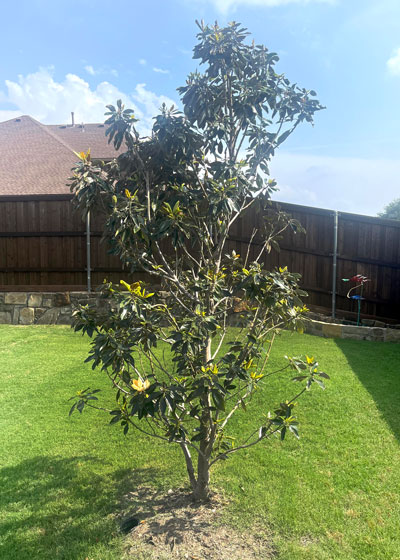
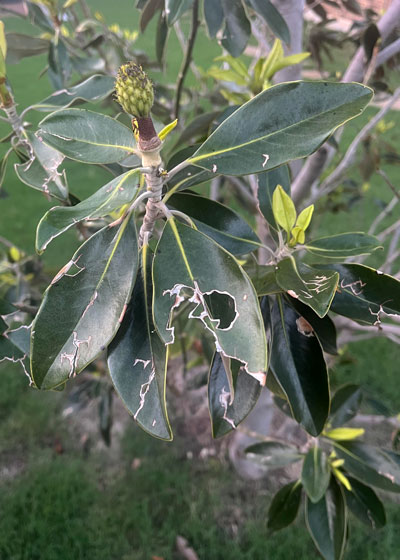
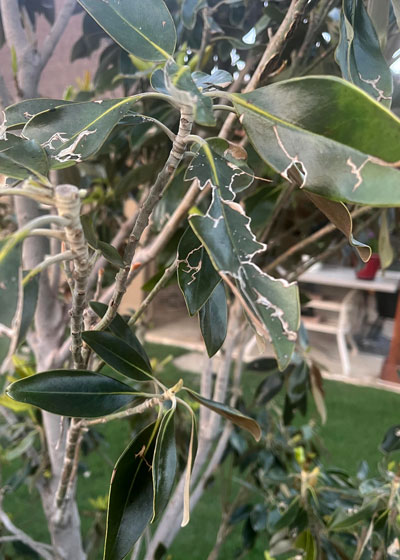
Answer: This is old damage (2023) of leaf miners. The larvae tunnel within the leaf tissues before emerging as adult flies. I must confess that I see this on my magnolias, but I haven’t felt the need for any control measures. Then again, I’ve never had an outbreak anywhere near as bad as what you’re experiencing.
North Carolina State University entomologists have a very useful, short fact sheet on these interesting pests. It might offer some suggestions. I will tell you that use of a systemic insecticide was what came to my mind first, although from this write up, it appears you might be too late for this generation. I would suggest for this year that you apply an all-nitrogen lawn food now as new leaves are emerging and follow that up with a deep watering. If you want to use a systemic insecticide at the same time, that certainly won’t hurt anything.
QUESTION 14
I AM CONCERNED THAT THIS PLANT THAT IS GROWING AGAINST MY HOUSE MIGHT DAMAGE THE FOUNDATION.
Question: I’m not sure if this is a tree or a shrub, but it’s growing right up against my house. I’m concerned that its roots might go beneath my foundation. What do you think? Wilma S., Brazoria County.

Answer: It looks like a holly to me, and it’s probably going to grow to be very tall. You definitely do not want it there, not so much because of the foundation, but more because of what it will do to your view, the window and eventually the eave. You could try digging and moving it next winter, or you could just take it out now.
